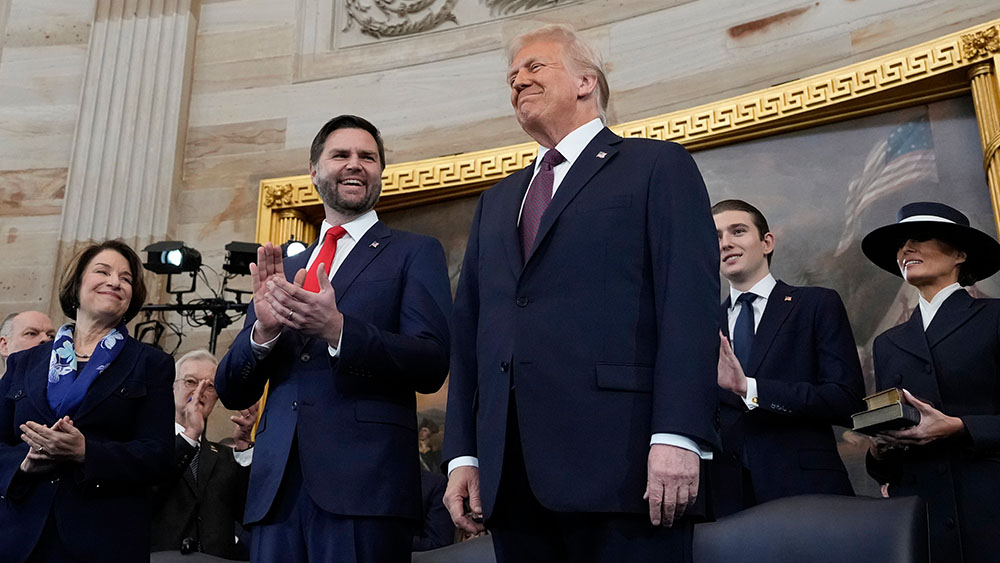- President Donald Trump plans to impose a 25% tariff on imports from Canada and Mexico, effective March 1, using the International Emergency Economic Powers Act as a legal basis.
- The tariffs aim to address the fentanyl crisis and illegal immigration, but critics warn that they could spark a trade war, increase inflation and harm American consumers and businesses.
- The decision threatens to disrupt nearly $1.6 trillion in annual trade between the U.S., Canada and Mexico, effectively dismantling the North American Free Trade Agreement (NAFTA) framework.
- Both Canada and Mexico have vowed to retaliate against the tariffs, with targeted measures against U.S. imports.
- The tariff strategy is part of a broader trade agenda that includes a 10% duty on Chinese imports, highlighting Trump’s willingness to use trade policy as a lever for geopolitical influence.
In a move that has sent shockwaves through global markets and strained diplomatic relations, President Donald Trump is poised to announce sweeping tariffs on imports from Canada and Mexico, effective March 1. The decision, which could upend decades of North American economic integration, is framed by the administration as a necessary step to combat the fentanyl crisis and illegal immigration. But critics warn it could spark a trade war, inflame inflation and harm American consumers and businesses.
A tariff plan with teeth—and exemptions
According to sources familiar with the matter, Trump is expected to impose a 25% tariff on imports from Canada and Mexico, with a limited process for exemptions. The tariffs, set to take effect on March 1, are designed to pressure America’s neighbors to crack down on the flow of fentanyl and illegal immigrants across the U.S. border.
The administration has hinted that exemptions may be granted for certain imports, such as Canadian oil, which is critical to U.S. energy security. “Any exemptions would be few and far between,” an administration official told Reuters, underscoring the administration’s intent to wield tariffs as a tool for policy change rather than a blanket economic measure.
Trump’s decision to invoke the International Emergency Economic Powers Act (IEEPA) as the legal basis for the tariffs adds a dramatic layer to the announcement. Enacted in 1977 and expanded after 9/11, the IEEPA grants the president broad authority to impose economic sanctions during a national emergency. By declaring the fentanyl crisis and illegal immigration as emergencies, Trump is positioning the tariffs as a matter of national security.
“We’ve got the Super Bowl coming up, and eerily, the amount of people that fit in the [New Orleans] Superdome are almost exactly equal to the number of people dying every year here in America from fentanyl,” Trump trade advisor Peter Navarro told CNBC. “This is why we have these kinds of discussions.”
A threat to North American trade
The proposed tariffs threaten to disrupt nearly $1.6 trillion in annual trade between the U.S., Canada and Mexico, effectively dismantling the 30-year-old North American Free Trade Agreement (NAFTA) framework that has deeply integrated the three economies. Economists and business leaders warn that the tariffs will lead to higher prices for American consumers, particularly for goods like aluminum, lumber, fruits, vegetables and automobiles.
“President Trump’s tariffs will tax America first,” said Matthew Holmes, public policy chief at the Canadian Chamber of Commerce. “From higher costs at the pumps, grocery stores and online checkout, tariffs cascade through the economy and end up hurting consumers and businesses on both sides of the border.”
Canadian Prime Minister Justin Trudeau has vowed swift retaliation, with targeted measures against U.S. imports, including orange juice from Florida—Trump’s adopted home state. “It’s not what we want, but if he moves forward, we will also act,” Trudeau said.
Mexico, too, has signaled its readiness to respond. President Claudia Sheinbaum emphasized her commitment to defending Mexico’s sovereignty and dignity, stating, “We will always defend the dignity of our people, respect for our sovereignty, and a dialogue as equals without subordination.”
A broader trade strategy
The tariffs on Canada and Mexico are part of a broader trade strategy that includes a 10% duty on Chinese imports, aimed at punishing Beijing for its alleged role in the fentanyl trade. While the administration has not provided details on how the China tariffs will be implemented, the move underscores Trump’s willingness to use trade policy as a lever for geopolitical influence.
However, the decision to impose tariffs on two of America’s closest allies has raised eyebrows, even among some conservatives. Critics argue that the move risks alienating key partners at a time when global economic stability is already fragile.
“If they keep threatening and then don’t put them in place, they’re going to lose credibility,” a U.S. trade group executive told Reuters, speaking on condition of anonymity.
Historical context and the road ahead
The Trump administration’s tariff strategy harkens back to the protectionist policies of the early 20th century, when tariffs were used to shield domestic industries from foreign competition. However, the modern global economy is far more interconnected, and the potential for retaliatory measures is significant.
The decision also comes at a critical juncture for the U.S. economy. Inflation, while showing signs of easing, remains a concern, and the Federal Reserve is closely monitoring the impact of fiscal policy. “It will be very important to have a better sense of the actual policies and how they will be implemented,” Fed Governor Michelle Bowman said.
As the March 1 deadline approaches, the world will be watching to see whether Trump’s tariff gamble pays off—or whether it ignites a trade war that could have lasting repercussions for North America and beyond.
For now, one thing is clear: Trump is doubling down on his America First agenda, betting that tough trade measures will secure the border and protect American lives. Whether this bold strategy will succeed or backfire remains to be seen.
Sources include:
